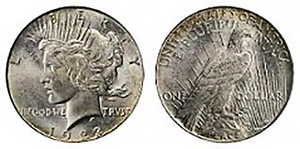Shore Collectibles
By Douglas Keefe, President of Beachcomber Coins
Silver dollars featuring the design by Charles Morgan were struck continually from 1878 until 1904 when production ceased due to an abundance of coins residing in government vaults and no demand for them to be released to the public for use in commerce. As a result the government had no need to purchase additional silver, causing a hardship amongst silver mine owners. To help the mine owners, Senator Pittman from Nevada (where most of the mines were located), helped enact a federal law that went in effect in 1918 authorizing the converting to bullion 350 million silver dollars by melting and refining the coins, and selling the bulk to Great Britain at $1 per ounce. The small amount remaining was to be used for minting minor silver coins. The act also authorized the purchase of enough silver to replace the melted silver dollars at the rate of $1 per ounce which was over the market price of silver, thereby providing a government subsidy to the mine owners.
Silver was purchased and by 1921 all three mints, Philadelphia, Denver and San Francisco were prepared to resume minting silver dollars using the Morgan design, resulting in the highest mintage figure in one year, over 80 million coins total from all 3 mints.

In conjunction with this activity, there was an effort under way to strike a commemorative coin celebrating the successful end of World War I. A new design for a silver dollar was proposed featuring the Goddess Liberty facing left (a much younger appearance from the previous design) on the front of the coin, and the reverse with a bald eagle at rest facing a rising sun clutching an olive branch symbolizing peace in his claw and the word “PEACE” underneath around the rim. A previous design included a broken sword at the base, but it felt this signified defeat, so in was eliminated.
Approval of the new design was obtained in 1921, but all mints were running a maximum minting the old design coins, but dies were finally made and production begun by the end of December with the Philadelphia Mint striking 1 million of the new coins.
Because the word “PEACE” is on the coin and the purpose was to commemorate the peace that followed the end of World War I, the coin is aptly referred to as the Peace Dollar verses its’ predecessor the Morgan Dollar which was named after its’ designer. The Peace Dollar was minted from 1921 to 1928 and then 1934 and 1935. From a collectors perspective it is a short and easy set to complete, comprised of only 24 coins representing coins struck by all mints. If one were to assemble a date set (one coin for each year, regardless of the mint, it would require only 10 coins to complete.
The first year coin, 1921, is unique in the series and the second lowest mintage of 1 million coins. The lowest is the 1928 Philadelphia minted dollar with 360,000 struck. What makes the 1921 unique is the fact that it was struck in high relief, giving the features amore life-like appearance. Unfortunately this high relief caused minting problems and bankers complained that the coins wouldn’t stack properly, so the coin was redesigned, lowering the design of Liberty on the front and the eagle on the reverse.
Collecting a full 24 coin set in circulated condition would require paying around $200 for the 1928-P and $90 for the 1921. The 10 coin date set would still require purchasing a 1921, but the 1928-P could be replaced with a 1928-S, which is considerably cheaper. The 24 coin set could be completed for under $1000 while the 10 coin set under $500. If a collector were to try to assemble an uncirculated set of 24 coins, the budget would have to be considerably higher. I purchased an uncirculated set for $2500 which did not include the 1934-S, which by its-self is worth around $3000.
As a footnote to the Peace Dollar series, in 1964 the government authorizing the striking of silver dollars which resulted in the Denver mint during 1965 striking over 300,000 silver dollars with the 964 date. Because the price of silver in the coin was higher that the face value and the knowledge that these coins would never circulate because of that fact, the coins were never released and all (we think) were melted.






